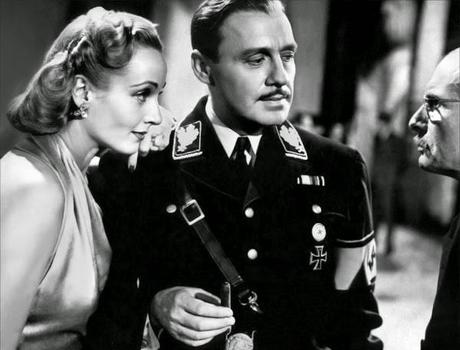 When Ernst Lubitsch's To Be or Not To Be (1942) hit theaters at the height of World War II, many critics attacked it as inappropriately lighthearted. Funny that few leveled similar complaints against Charlie Chaplin's goofier The Great Dictator (1940), or Lubitsch's own Ninotchka (1938), which turns Stalin's Red Terror into a punchline. Lubitsch's droll approach produces laughs while remaining relatively grounded.
When Ernst Lubitsch's To Be or Not To Be (1942) hit theaters at the height of World War II, many critics attacked it as inappropriately lighthearted. Funny that few leveled similar complaints against Charlie Chaplin's goofier The Great Dictator (1940), or Lubitsch's own Ninotchka (1938), which turns Stalin's Red Terror into a punchline. Lubitsch's droll approach produces laughs while remaining relatively grounded.Ham actor Josef Tura (Jack Benny) and his wife Maria (Carole Lombard) perform Shakespeare in Warsaw's theaters. Their relationship is strained, with Maria seeing gallant Air Force pilot Sobinski (Robert Stack) on the side. The Nazis invade and Sobinski becomes an RAF pilot; he's galled by double agent Professor Siletsky (Stanley Ridges) into exposing Polish Resistance fighters. The Polish underground recruits Maria to seduce the Professor, while Josef pulls an elaborate con against Gestapo Colonel Ehrhardt (Sig Ruman).
A collaboration between Hollywood and England's Korda Brothers, To Be or Not to Be contains the expected rabble rousing. Writers Melchior Lengyor and Edwin Justus Mayer insert narration denouncing Nazi terror, lauding Polish resistance and their pilots-in-exile. After the Warsaw ghetto uprising, Operation Tempest and the Nazis' destruction of the city, it's hard to appreciate the lighthearted resistance scenes. The fatalism of Fritz Lang's Hangmen Also Die! (1943) seems more appropriate.
Yet To Be's topical content grounds things enough to avoid frivolity. Lubitsch's great gift came in balancing tones: after a screwball first act, To Be's mood turns somber before the playful resistance caper. Maria's worldly wit and surprising spy skills catch our attention, while Siletsky proves a surprisingly seductive avatar of Fascism. This humanization extends to minor characters, like the hammy Hitler impressionist (Tom Dugan) or the Jewish actor (Felix Bressert) who dreams of playing Shylock - and gets his chance under the worst circumstances.
The movie's big laughs naturally go to Josef. We glimpse his monumentally awful Hamlet: one German remarks that "What he did to Shakespeare we're doing now to Poland." Yet he proves a surprisingly adept impersonator, bamboozling Erhart and his Teutonic twits. To Be's best scene is a prolonged bluff where Josef impersonates Siletsky, goading Ehrhardt into yanking off his beard. The movie climaxes in a Hitler-centric switcheroo that prefigures Inglorious Basterds, without the face-shooting.
Jack Benny scores by underplaying Josef; relishing the snappy dialogue, he's fun deceiving German baddies and goggling at his unfaithful wife. Carole Lombard matches him with charm, wit and resourcefulness: Maria's a far better actress than her husband. Tragically, Lombard died in a plane crash before To Be's release. Stanley Ridges (They Died With Their Boots On) makes a charming villain, though Sig Ruman's already rehearsing his Stalag 17 character. Robert Stack gets his breakthrough role, playing Maria's lover.
Whatever its contemporary reception, To Be or Not to Be is rightly regarded as a classic. Mel Brooks remade the film forty-one years later in inimitably broad fashion. Funny as Brooks' version is, he misses the wit and topicality of Lubitsch's original - but then, matching Lubitsch is a tall order for anyone.

